1995 PONTIAC BONNEVILLE engine
[x] Cancel search: enginePage 2 of 338
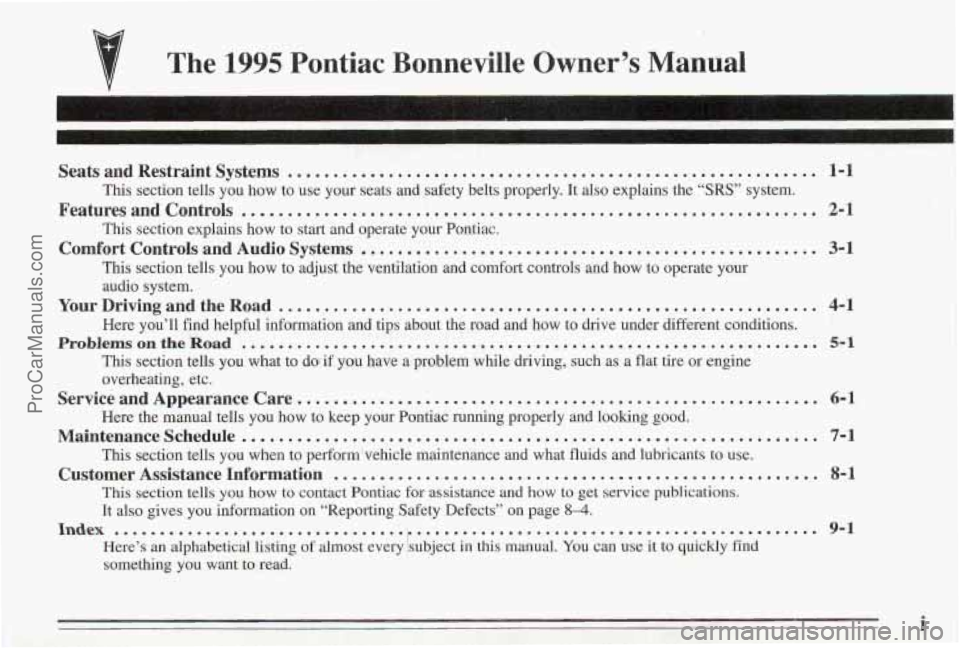
The 1995 Pontiac Bonneville Owner’s Manual
Seats and Restraint Systems .......................................................... 1-1
Features and Controls ............................................................... 2-1
Comfort Controls and Audio Systems .................................................. 3-1
This section tells you how to use your seats and safety belts\
properly. It also explains the “SRS” system. This section explains how to start and operate your Pontiac.
This section tells you how to adjust the ventilation and comfo\
rt controls and how to operate your audio system.
Here you’ll find helpful information and tips about the road\
and how to drive under different conditions.
This section tells
you what to dorif you have a problem while driving, such as a fl\
at tire or engine
overheating, etc.
Here the
rrmmal tells you how to keep your Pontiac running properly and loolun\
g good.
This section tells you when to perform’vehicle maintenance and wha\
t fluids and lubricants to use.
This section tells you how to contact Pontiac for assistance a\
nd how to get service publications.
It also gives you information on “Reporting Safety Defects’\
’ on page
8-4.
Here’s an alphabetical listing of almost every jsubject in this manual. You can use it to quickly find
something you want to read.
YourDrivingandtheRoad ........................................................... 4-1
ProblemsontheRoad ............................................................... 5-1
Service and Appearance Care ......................................................... ,6-1
Maintenanceschedule ............................................................... 7-1
Customer Assistance Information ..................................................... 8-1
Index ........................................................................\
....... 9-1
1
ProCarManuals.com
Page 6 of 338
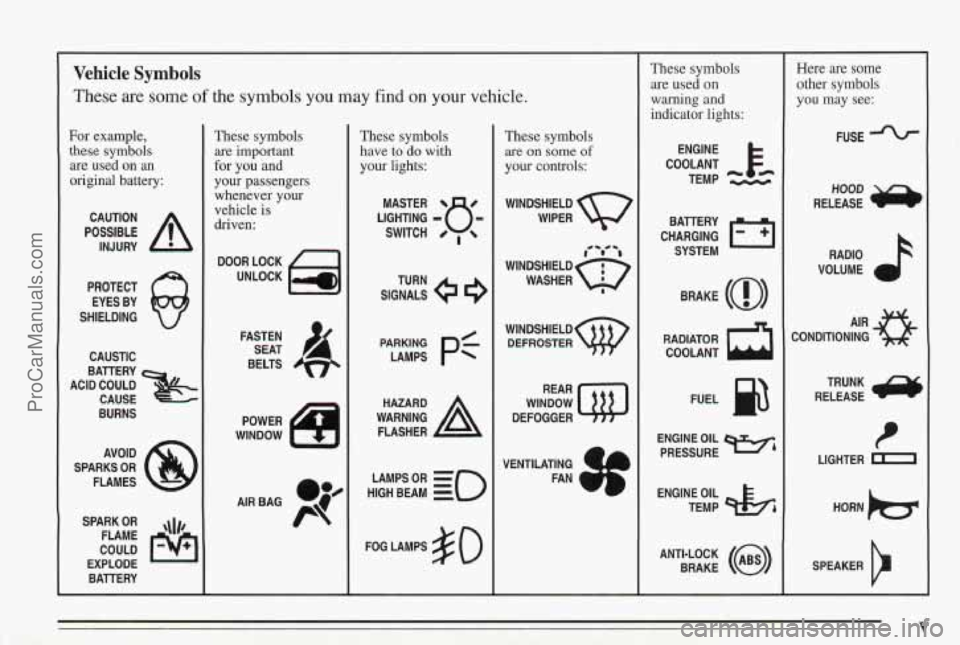
Vehicle Symbols
These are some of the symbols you may find on your vehicle.
For example,
these symbols
are used on
an
original battery:
POSSIBLE A
CAUTION
INJURY
PROTECT EYES BY
SHIELDING
CAUSTIC
ACID COULD BATTERY
CAUSE
BURNS
AVOID
SPARKS
OR
FLAMES
SPARK
OR ,\I/,
COULD FLAME
EXPLODE BAllERY
These symbols are
important
for you and
your passengers
whenever your
vehicle
is
driven:
DOOR LOCK
UNLOCK
FASTEN SEAT
4
BELTS
POWER
WINDNOW
These symbols
have
to do with
your lights:
SIGNALS 9
TURN
HIGH
LAMPSoR BEAM = =o
FOG LAMPS $0
These symbols
are on some of
your controls:
WIPER w
WINDsHIELDw DEFROSTER
WINDOW
DEFOGGER
VENTILATING
4 1
FAN CI
These symbols are used on
warning
and
indicator lights:
COOLANT Fe
TEMP --
ENGINE
CHARGING
I-1
BATTERY SYSTEM
BRAKE
(0)
RADIATOR COOLANT
a
FUEL @
ENGINE OIL
PRESSURE Wb
TEMP OIL 45
ANTI-LOCK (@)
BRAKE
Here are some
other symbols
you may see:
FUSE
RADIO
VOLUME
CONDITIONING
AIR 43
TRUNK
RELEASE
t
LIGHTER n
SPEAKER
V ProCarManuals.com
Page 59 of 338
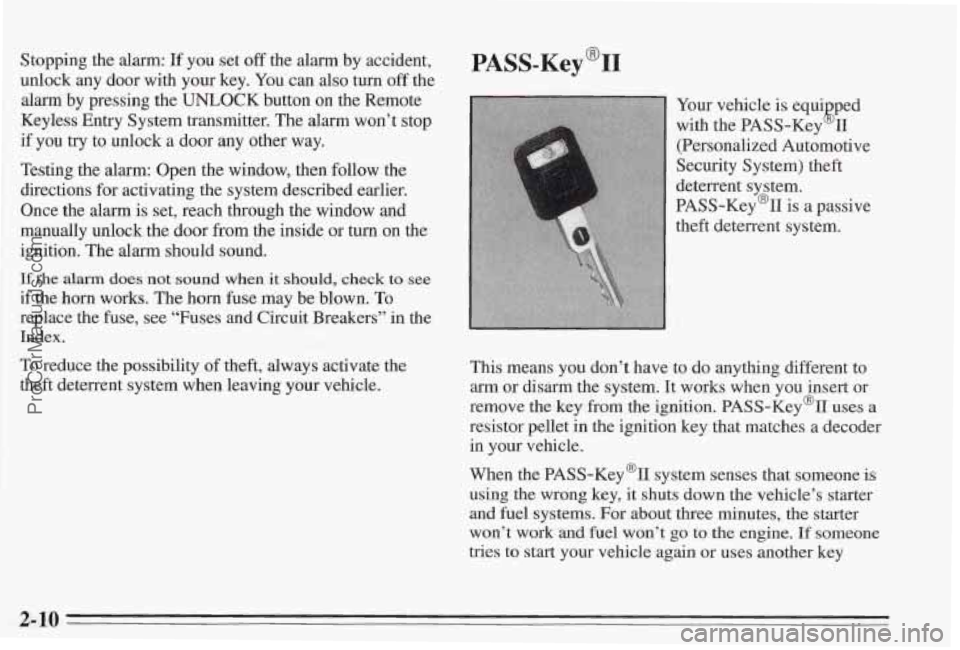
Stopping the alarm: If you set off the alarm by accident,
unlock any door with your key.
You can also turn off the
alarm by pressing the UNLOCK button on the Remote
Keyless Entry System transmitter. The
alarm won’t stop
if you try to unlock a door any other way.
Testing the alarm: Open the window, then follow the
directions for activating the system described earlier.
Once the
alarm is set, reach through the window and
manually unlock the door from the inside
or turn on the
ignition. The alarm should sound.
I€ the alarm does not sound when it should, check to see
if the horn works. The horn fuse may be blown. To
replace the fuse, see “Fuses and Circuit Breakers” in the
Index.
To reduce the possibility of theft, always activate the
theft deterrent system when leaving your vehicle.
PASS-Key@II
Your vehicle is equi -ed
with the PASS-Key II
(Personalized Automotive
Security System) theft
deterrent system.
PASS-Key(%
is a passive
theft deterrent system.
k?
This means you don’t have to do anything different to
arm or disarm the system. It works when you insert or
remove the
key from the ignition. PASS-Key% uses a
resistor pellet in the ignition key that matches a decoder
in your vehicle.
When the PASS-Key% system senses that someone is
using the wrong key, it shuts down the vehicle’s starter
and fuel systems.
For about three minutes, the starter
won’t work and
fuel won’t go to the engine. If someone
tries to start your vehicle again
or uses another key
2-10
ProCarManuals.com
Page 60 of 338
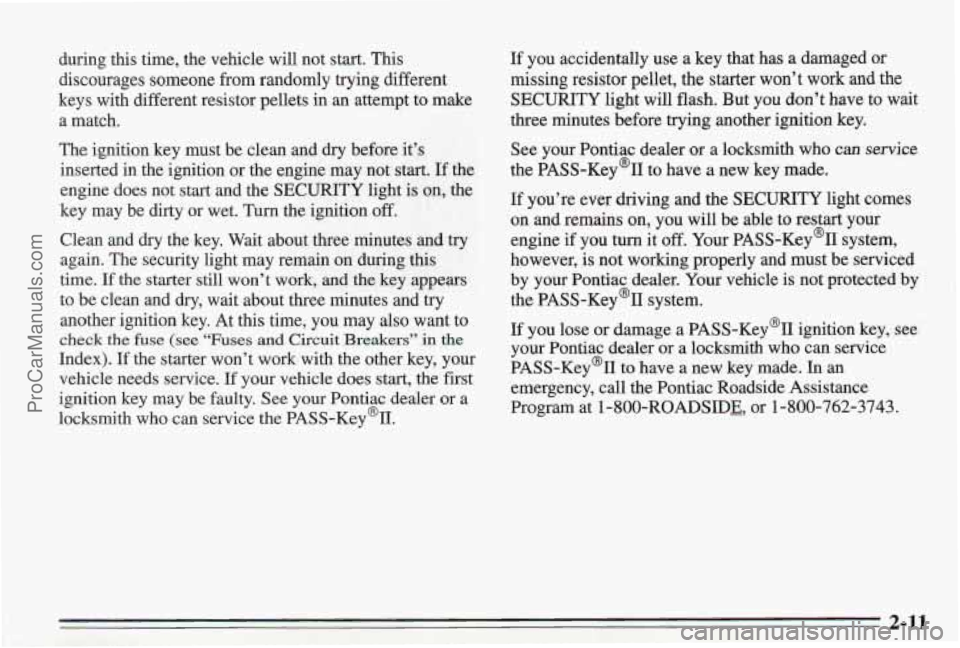
during this time, the vehicle will not start. This
discourages someone from randomly trying different
keys with different resistor pellets in an attempt to make
a match.
The ignition key must be clean and
dry before it’s
inserted in the ignition or the engine may not start. If the
engine does not start and the SECURITY light is on, the
key may be dirty or wet. Turn the ignition
off.
Clean and dry the key. Wait about three minutes and try
again. The security light may remain on during this
time. If the
starter still won’t work, and the key appears
to be clean and
dry, wait about three minutes and try
another ignition key. At this time, you may also want to
check the fuse (see “Fuses and Circuit Breakers” in the
Index). If the starter won’t work.with the other key, your
vehicle needs service. If your vehicle does start, the first
ignition key may be faulty.
See your Pontiac dealer or a
locksmith who can service the PASS-Key@II. If
you accidentally use a key that has
a damaged or
missing resistor pellet, the starter won’t work and the
SECURITY light will flash. But you don’t have to wait
three minutes before trying another ignition key.
See your Pontiac dealer or a locksmith who can service
the PASS-Key’II to have
a new key made.
If you’re
ever driving and the SECURITY light comes
on and remains on, you will be able to restart your
engine if you
turn it off. Your PASS-K~Y~I system,
however, is not working properly and must be serviced
by your Pontiac dealer. Your vehicle is not protected by
the PASS-Key% system.
If you lose or damage a PASS-Key(% ignition key, see
your Pontiac dealer or a locksmith who can service
PASS-Key@II to have a new key made. In an
emergency, call the Pontiac Roadside Assistance
Program at
1 -800-ROADSID& or 1-800-762-3743.
2-11
ProCarManuals.com
Page 61 of 338
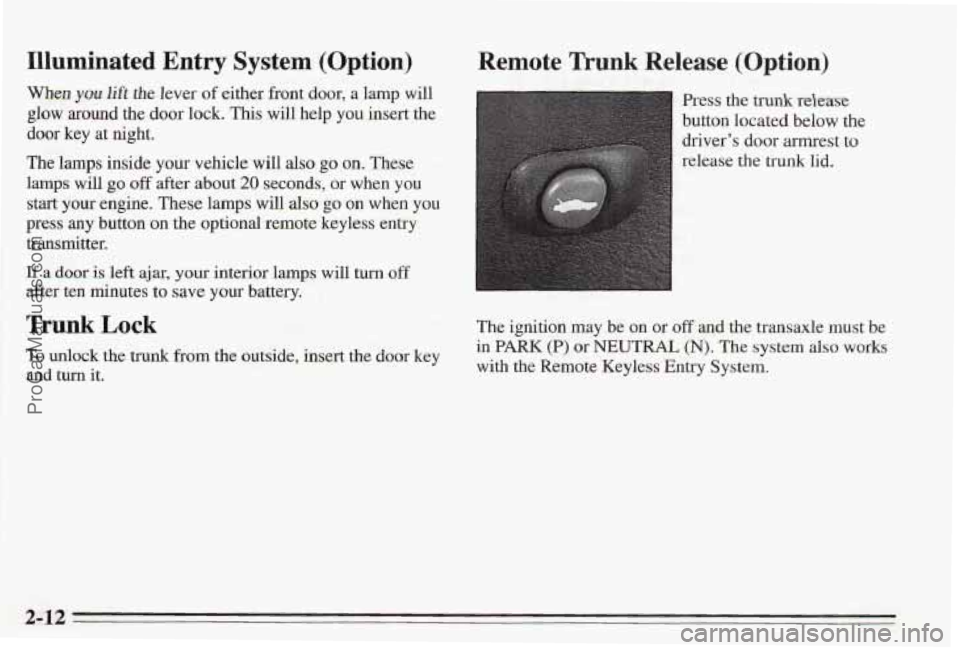
Illuminated Entry System (Option)
When you lift the lever of either front door, a lamp will
glow around the door lock. This will help you insert the
door key at night.
The lamps inside your vehicle will also
go on. These
lamps
will go off after about 20 seconds, or when you
start your engine. These lamps will
also go on when you
press any button on the optional remote keyless entry
transmitter.
If a door is left ajar, your interior lamps will turn off
dter ten minutes to save your battery.
Trunk Lock
To unlock the trunk from the outside. insert the door key
and turn it.
Remote Trunk Release (Option)
Press the trunk relase
button located below the
driver's door armrest to
release the trunk
lid.
The ignition may be on or off and the transaxle must be
in PARK (P) or NEUTRAL (N). The system also works
with the Remote Keyless Entry System.
2-12
ProCarManuals.com
Page 63 of 338
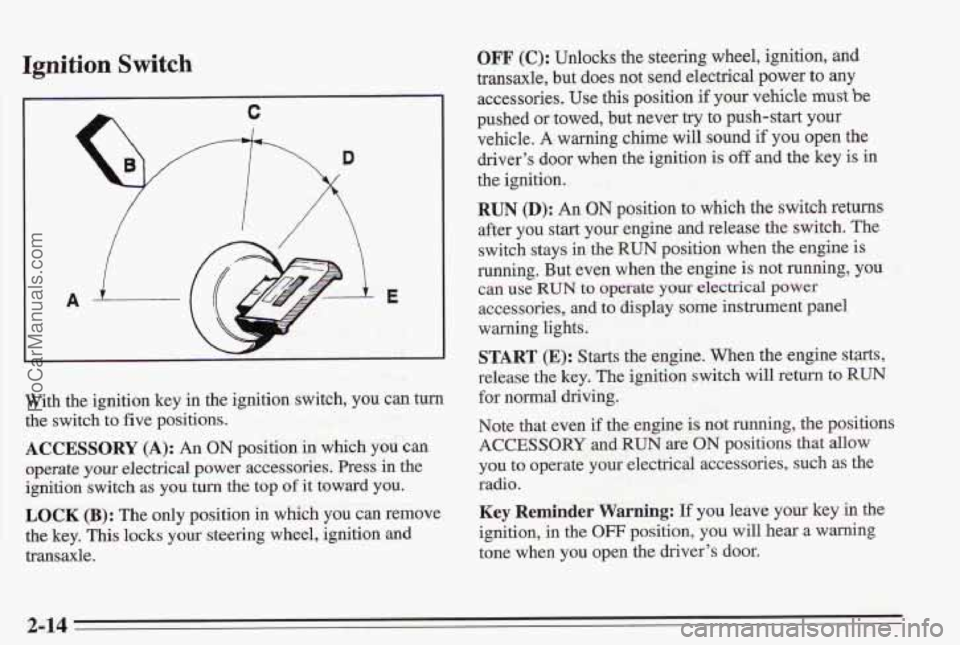
Ignition Switch
With the ignition key in the ignition switch, you can turn
the switch to five positions.
ACCESSORY (A): An ON position in which you can
operate your electrical power accessories. Press in the
igniti’on switch as you turn the top of it toward you.
LOCK (B): The only position in which you can remove
the key, This locks your steering wheel, ignition and
transaxle.
OFF (e): Unlocks the steering wheel, ignition, and
transaxle, but does not send electrical power to any
accessories.
Use this position if your vehicle me be
pushed or towed, but never try to push-start your
vehicle.
A warning cbime will sound if you open the
driver’s door when the ignition
is off and the key is in
the ignition.
RUN 0): An ON position to which the switch returns
after you start your engine and release the switch. The
switch stays in the RUN position when the engine is
running. But even when the engine is not running, you
accessories,
and to display some instrument panel
warning lights.
§TART (E): Starts the engine. When the engine starts,
release de key. The ignition switch will return to
RUN
for normal driving.
Note that even if
the engine is not running, the positions
ACCESSORY and RUN are ON positions that allow
you to operate
yom electrical accessories, such as the
radio.
Key Reminder Warning: If you leave your key in the
ignition, in the OFF position, you will hear a warning
tone when you open the driver’s door.
CEUl Use Rm to QPe3Tit.e yOlar &C!T’kd power
2-14 ProCarManuals.com
Page 64 of 338
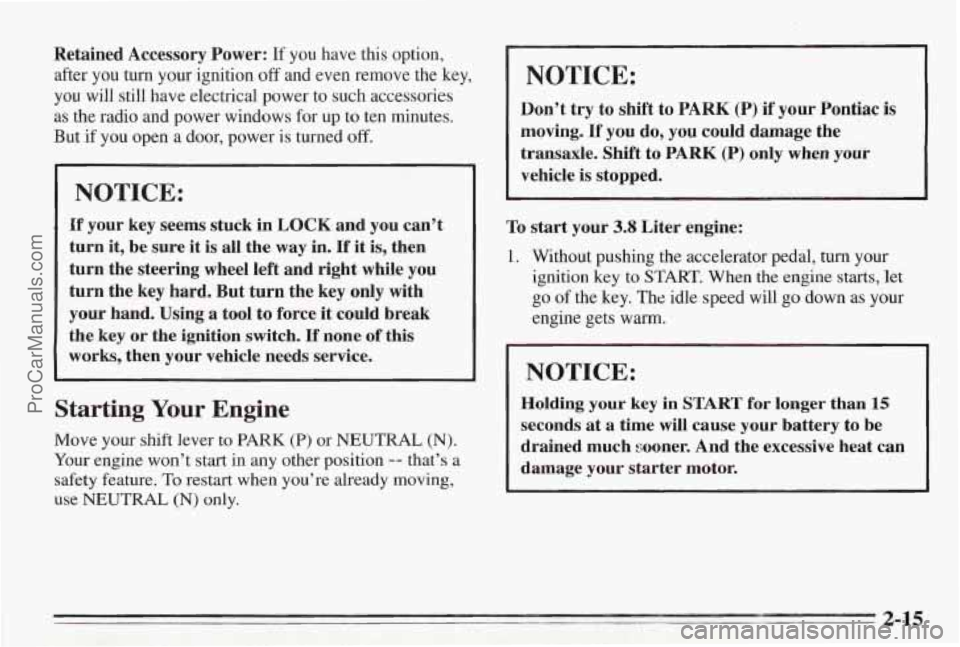
Retained Accessory Power: If you have ths option,
after you turn your ignition
off and even remove the key,
you will still have electrical power to such accessories
as the radio and power windows for up to ten minutes.
But if you open
a door, power is turned off.
NOTICE:
If your key seems stuck in LOCK and you can’t
turn it, be sure it is all the way in.
If it is, then
turn the steering wheel left and right while you
turn the key hard. But turn the key only with
your hand. Using a tool to force it could break
the key
or the ignition switch. If none of this
works, then your vehicle needs service.
Starting Your Engine
Move your shift lever to PARK (P) or NEUTRAL (N).
Your engine won’t start in any other position -- that’s a
safety feature.
To restart when you’re already moving,
use
NEUTRAL (N) only.
NOTICE:
Don’t try to shift to PARK (P) if your Pontiac is
moving. If you do, you could damage the
transaxle. Shift to PARK
(P) only when your
vehicle is stopped.
To start your 3.8 Liter engine:
1. Without pushing the accelerator pedal, turn your
ignition key to
START. When the engine starts, let
go of the key. The idle speed will go down as your
engine gets
warm.
NOTICE:
Holding your key in START for longer than 15
seconds at a time will cause your battery to be
drained much sooner.
And the excessive heat can
damage your starter motor.
2-15
ProCarManuals.com
Page 65 of 338
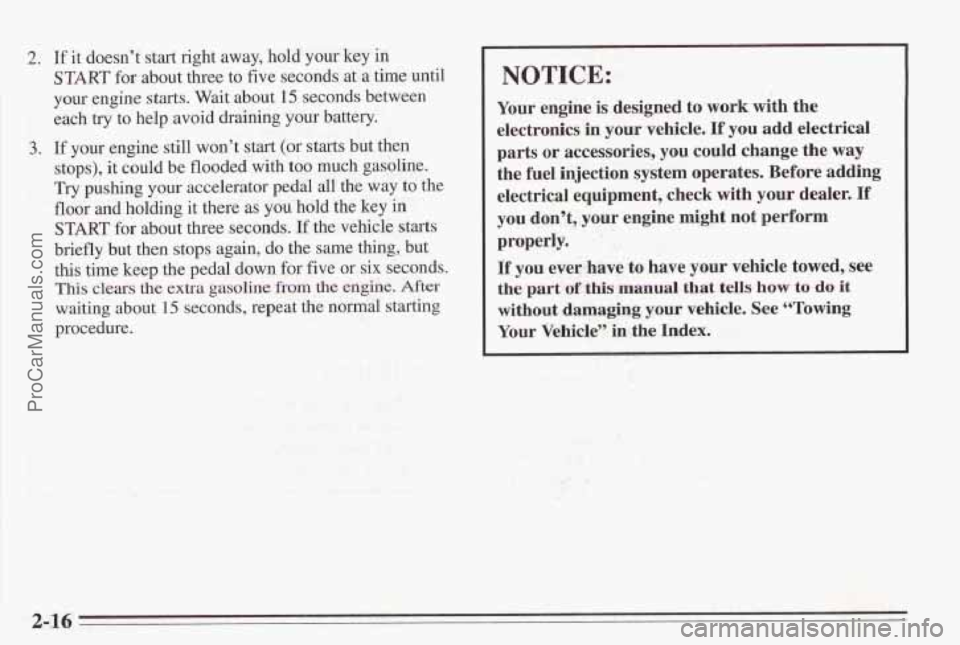
2. If it doesn’t start right away, hold your key in
START for about three to five seconds at a time until
your engine starts. Wait about
15 seconds between
each try
to help avoid draining your battery.
3. If your engine still won’t start (or starts but then
stops), it could be flooded with
too much gasoline.
Try pushing
your accelerator pedal all the way to the
floor and holding it there as you hold
the key in
START for about three seconds. If the vehicle starts
briefly but then stops again, do
the same thing, but
this
time keep the pedal down far five or six seconds.
This clears the extra gasoline €rom the engine. After
waiting about 15 seconds, repeat the nod starting
procedure.
NOTICE:
Your engine is designed to work wkh the
electronics
in your vehicle. If you add electrical
parts or accessories, you could change the way
the fuel injection system operates. Before adding
electrical equipment, check with your dealer.
If
you don’t, your engine might not perform
properly.
If you everhave to have your vehicle towed, see
the part of this manual that tells how to do it
without damaging your vehicle. See “Towing
Your Vehicle” in the lndex.
2-16
ProCarManuals.com